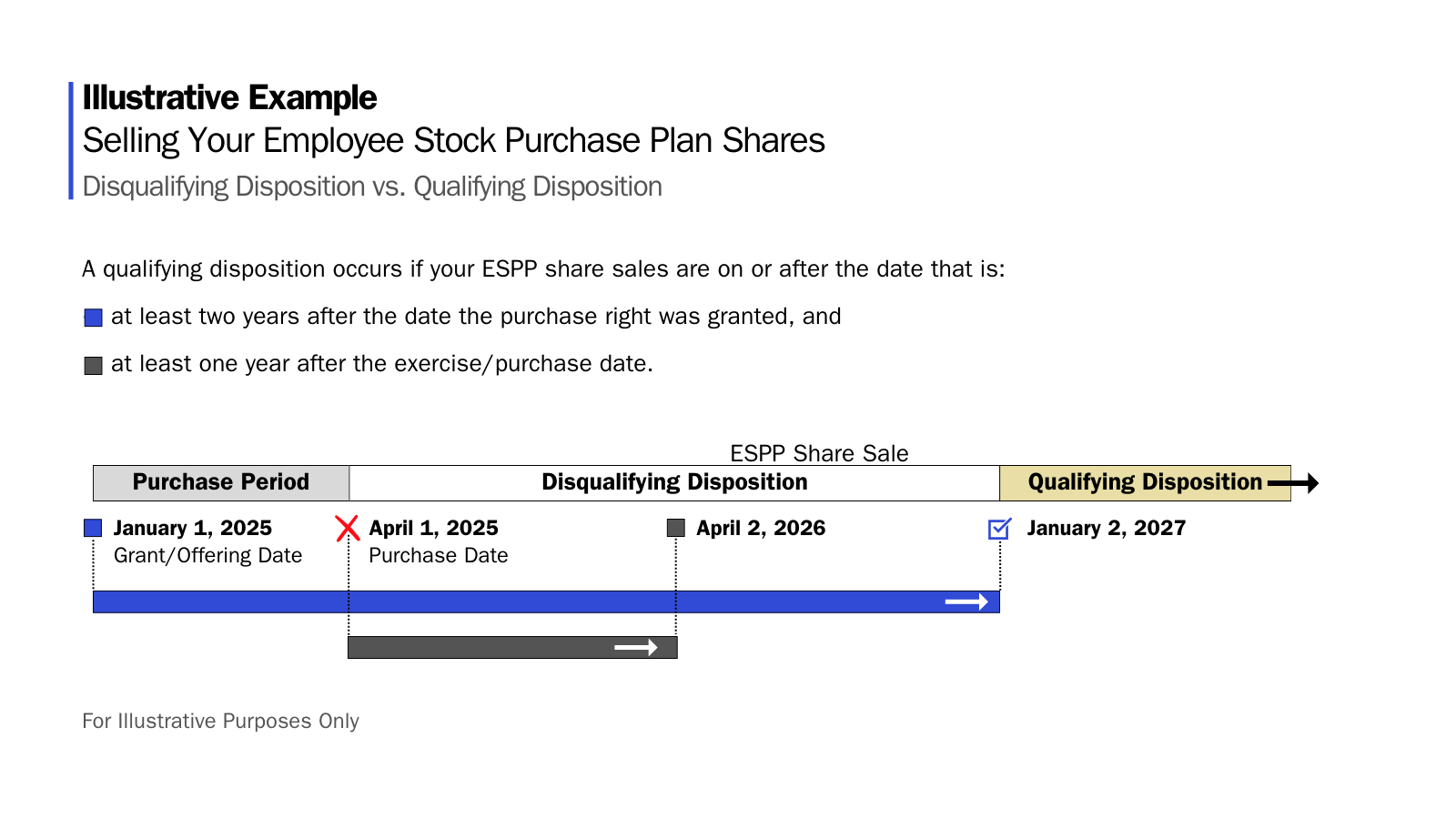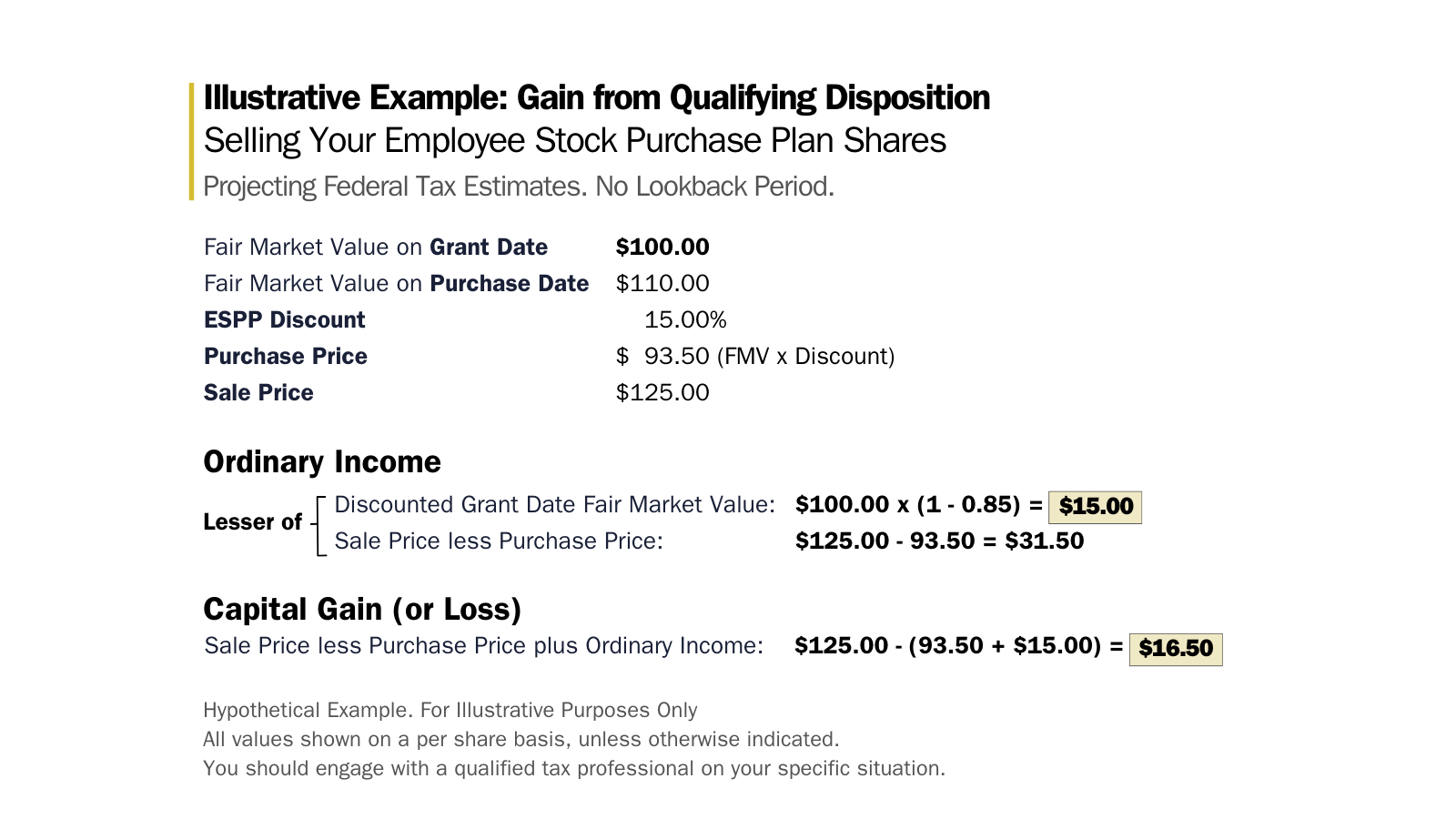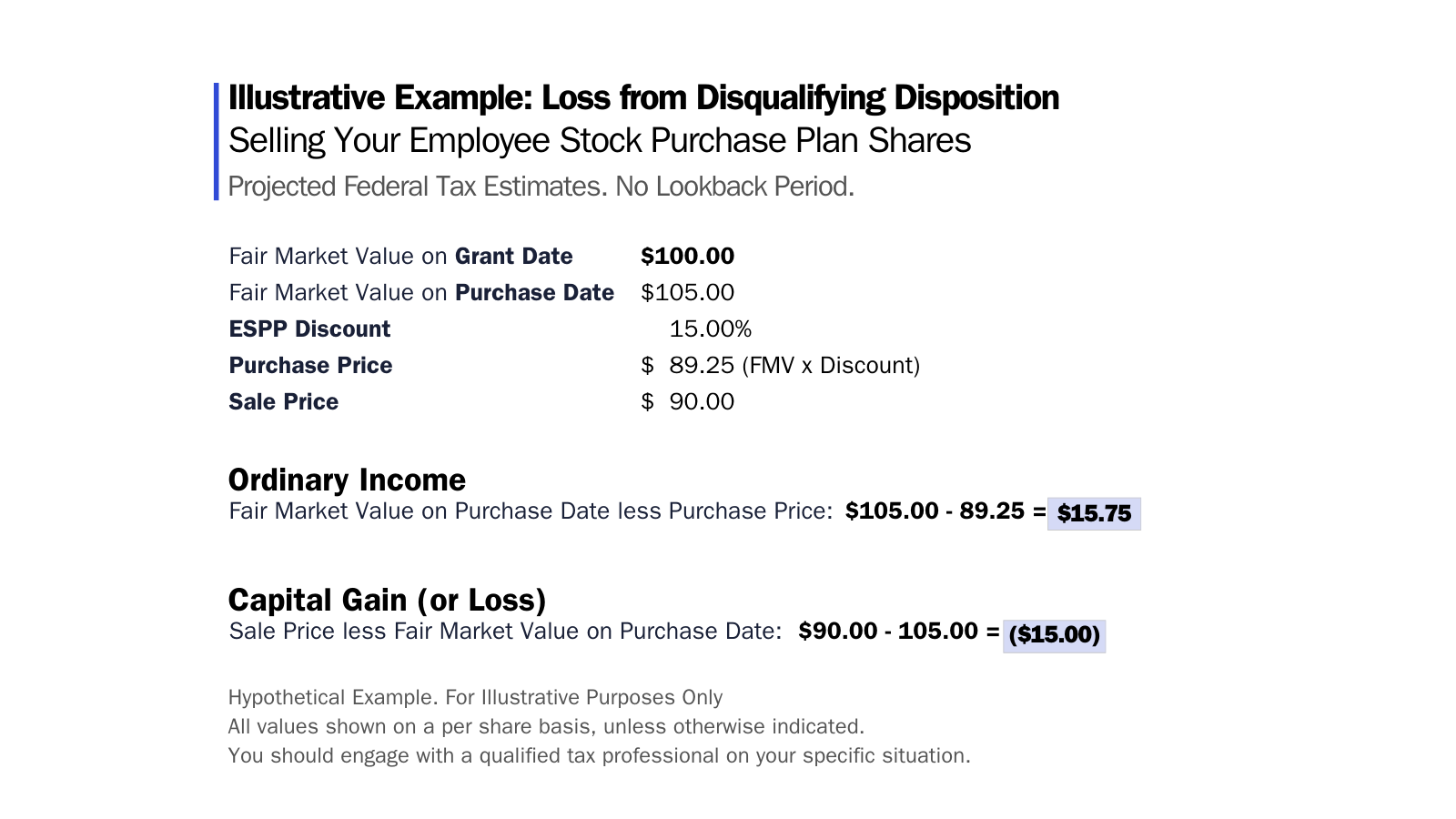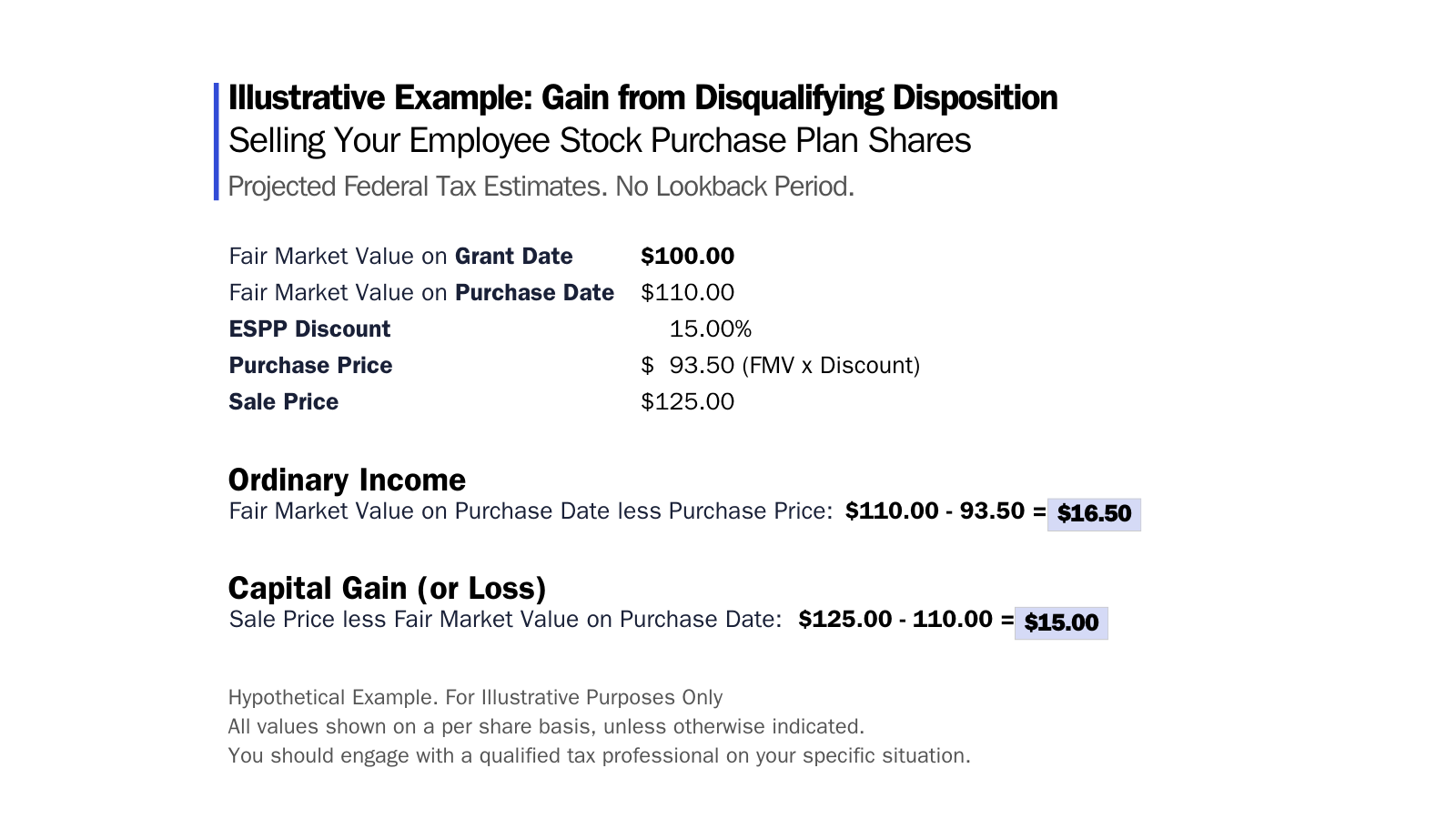If you participate in an employee stock purchase plan (ESPP) in 2025, read on to better understand qualifying and disqualify dispositions. Understand what you need to know before selling your ESPP shares. Feel more confident and prepared during your next ESPP enrollment window.
Learning Points
ESPP Share Sales: Qualifying Dispositions vs. Disqualifying Dispositions
For this discussion, we assume you are eligible to participate in a qualified employee stock purchase plan (ESPP). Meaning, the ESPP fulfills the related regulatory requirements of Section 423 of the Internal Revenue Code. You’ll want to confirm with your employer whether your ESPP qualifies.
When you sell your employee stock purchase plan shares, there are two ways your ESPP share sales are characterized:
- Qualifying Disposition, or
- Disqualifying Disposition
Below is an illustrative example that ties together key concepts and terms you might encounter when you are evaluating whether to continue to hold or sell your ESPP shares.

Because topics like employee stock purchase plans, like so many others in financial planning, intersect with the world of tax, make sure you coordinate with your qualified tax professional.
Let’s dive into the details of when your ESPP shares are characterized as a qualifying or disqualifying disposition.
Qualifying Disposition
A qualifying disposition occurs if you sell your ESPP shares on or after the date that is at least:
- two years after the date the purchase right was granted, and
- one year after the exercise date.
In a qualifying disposition, you allocate the sale of ESPP shares into ordinary income and capital gains/losses, and you can project your taxes in the following way:
Ordinary Income: If the fair market value of the shares at the time the purchase rights were granted is below the exercise price at the date of grant, you can project as ordinary income, the lesser of:
- The excess of the fair market value of the shares as of the grant date over the exercise price. (i.e., the discounted amount of the share price), or
- The excess of the fair market value of the shares at the time of sale over the amount paid for the shares.
Capital Gain/Capital Loss: Any further gain or loss on the disposition will be treated as capital gain or capital loss, respectively.
Here is an illustrative example of a qualifying disposition.

Disqualifying Disposition
If you sell shares of stock acquired through your ESPP before the expiration of either of the holding periods described in the qualifying disposition above, the excess of the FMV of the shares on the exercise date over the exercise price will be treated as ordinary income to the employee in the year of the disposition.
This excess will constitute ordinary income in the year of sale or other disposition, even if no gain (or a loss) is realized on the sale (or a gratuitous transfer of the shares is made).
The balance of any gain will be treated as capital gain. Even if the shares are sold for less than their FMV on the exercise date, the same amount of ordinary income is attributed to an employee, and a capital loss is recognized equal to the difference between the sale price and the FMV of the shares on the exercise date.
For a more detailed discussion on investment taxes, the following article provides additional insights.
Hopefully this framework gives you a sense of the timing and considerations around participating in your employee stock purchase plan. Topics like your ESPPs, like so many others in financial planning, intersect with the world of tax, make sure you coordinate with a qualified tax professional on your specific situation.
To help you better understand the relationship between the different terms and sale timing, here are illustrative examples of both a disqualifying disposition for a loss and a gain, respectively.


Setting aside the right amount for your tax payments: Once you have a reliable projection of how your share sales will be taxed, set aside those funds in an account you earmarked to hold your future tax payments.
Does Holding or Selling Your ESPP Shares Better Align with Your Goals?
Hopefully you found this discussion of qualifying dispositions and disqualifying dispositions of ESPP shares helpful and educational.
Does holding your ESPP shares in 2025 move you closer to your savings priorities? Does it mean you need to make some tradeoffs? If so, what’s the right mix of solutions for you or your family?
You’ll want to evaluate your employee stock purchase plan in the context of your personal situation.
Holding a significant portion of your wealth in your company’s stock can increase the concentration risk of your investments.
Doing so can decrease your investment portfolio’s diversification and could potentially take you away from achieving your financial goals.
Like any investment, you want to understand how to purchase, maintain, and sell your ESPP shares.
You’ll want to understand how an ESPP can support your overall financial goals. Whether that means you diversify your investments away from your employer’s stock to achieve your financial goals or continue to hold the shares for a specific purpose.
When an ESPP is one of the many pieces of your financial life, it’s important that you proactively and efficiently review, monitor, and take action on your ESPP-related holdings.
It’s within this context you can assess and quantify how your ESPP does, or does not, align with your goals. It’s easy to get lost in the details and lose sight of what truly matters.

The Next Step
Are you on track for your short-term goals, like making memories with your family by going on vacations together? How confidently are you approaching saving and investing for your long-term aspirations, like retiring or pursuing a meaningful second career?
We help busy parents and individual professionals like you develop financial plans to address questions like:
- How can we save for a fulfilling retirement beyond our 401(k) plans?
- What does it take to save for the kids’ education and make a lifetime of memories along the way?
- These causes are close to our hearts – what are our options to give even more meaningful support?
As your financial planner in Saint Louis, we can help you get organized and start feeling more confident that you are making progress towards your savings priorities.
Working with your financial planner in Saint Louis can provide you with the right mix of accountability, collaboration, and long-term thinking.
When you know who and what are truly important, we can help you create incredible clarity about your spending and savings priorities. Clarity to confidently save for and spend on what matters.
If you’re ready to take the next step together, let’s talk.
Disclosure
This commentary is provided for educational and informational purposes only and should not be construed as investment, tax, or legal advice. The information contained herein has been obtained from sources deemed reliable but is not guaranteed and may become outdated or otherwise superseded without notice. Investors are advised to consult with their investment professional about their specific financial needs and goals before making any investment decision.


